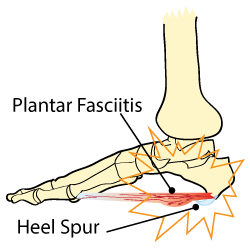
Anatomy Of The Foot
Plantar fasciitis and heel spurs are problems that can develop in the area of the heel on the sole of the foot, causing chronic pain and interfering with the ability to walk normally or comfortably.
The plantar fascia is a thick band of fibrous connective tissue that, lying atop the cushioning layers of fatty tissue that constitute the bottom of the foot, extends from the heel bone to the ball of the foot. Stress from mechanical problems, injury or overuse can cause the plantar fascia to become inflamed, creating pain.
A heel spur is a calcium deposit; "a growth of the bone" that can develop on the bottom of the heel bone where the muscles of the foot connect to the bone. This boney protrusion, which tends to resemble a hook or spur that points forward, can result from extended strain on the foot's muscles and ligaments, from the prolonged stretching and inflammation of the plantar fascia, and from repeated tearing of the membrane that covers the heel bone.
While many cases of plantar fasciitis and heel spurs can be dealt with through conservative, medical treatments, surgical correction may be necessary, though vary rarely.
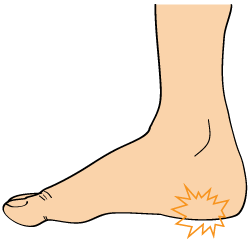
The Condition
The key sign of both plantar fasciitis and heel spurs is pain located directly underneath the heel. Although it is entirely possible to have a heel spur without experiencing any pain or other symptoms. Initially the pain may be mild, at this point such pain is often referred to as a stone bruise and it's likely to resolve with rest.
If you continue your stressful activity despite the pain, it can progress to the more serious development of plantar fasciitis and/or a heel spur. For this reason, it's important to give your feet the opportunity to recover from the moderate pain of stone bruises, and to seek treatment when pain continues before the condition becomes chronic. Generally, the longer you have had symptoms, the longer it will take to resolve the problem.
While resting your feet may give you relief, a characteristic of plantar fasciitis is that the relief tends to be only temporary, with the pain coming back as soon as you resume placing weight on your heels and stretch the plantar fascia. Although pain usually diminishes after a few minutes, it will return again as time on your feet goes on.
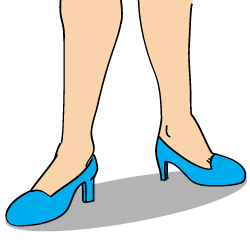
The Cause
Plantar fasciitis usually develops as a result of prolonged or repetitive straining over an extended period that causes the tissues of the fascia to be torn or stretched, at various points along it's length, resulting in painful inflammation.
Plantar fasciitis is perhaps most visibly associated with athletes whose activity involves them in a great deal of running and jumping, but anyone who stresses their feet, as in people whose work requires them to stand and walk on hard surfaces for extended periods is vulnerable to the problem. Mechanical motion imbalances, excessive weight and ill-fitting or excessively worn shoes can be important factors.
Heel spurs generally develop from stress on the muscles and ligaments of the foot, by plantar fasciitis. Inflammation of the plantar fascia caused by excessive, prolonged stretching and tear, and by repeated tearing of the membrane that covers the heel bone. The same athletic issues that cause plantar fasciitis can result in heel spurs, and the same issues of mechanical motion imbalance in the feet, excessive weight and poorly fitting or excessively worn shoes can be significant factors.
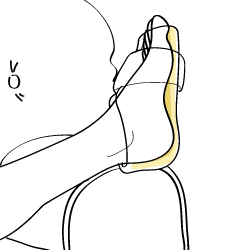
Treatment
The treatment is very much the same for both heel spurs and plantar fasciitis. While the below list is not a list of all treatment modalities, it is a list of the most common treatments for these conditions. If you are looking for the full treatment list, please visit our treatment page.
- Rest - Since both of these conditions are classified as repetitive stress disorders, one of the best things to do is rest your feet. Use a pair of crutches to help you through the day while resting your feet.
- Cold Compression - Using cold compression to help reduce inflammation and pain is a natural way to help heal your pained foot. Using cold compression instead of ice will help reduce inflammation a lot faster than just ice packs.
- Proper Shoes - Wearing shoes that have the proper support is very important in treating plantar fasciitis and heel spurs. Wearing properly fitting shoes help treat these painful foot conditions, but they can also help prevent them. Look for shoes that keep your feet in correct alignment.
For a full list of treatment methods, take a look at the treatment page.
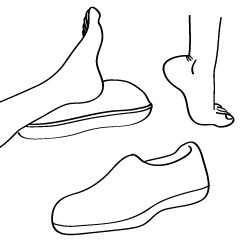
Prevention
The most important thing to do in order to avoid the development of plantar fasciitis or heel spurs is to take care of your feet.
- Rest your feet and let them recover if you experience pain such as the moderate pain problem called stone bruise. A mild, simple pain that is ignored can develop into a serious and complex problem. Pace yourself and protect your feet.
- Wear shoes that have shock absorbent soles and provide good support.
- Replace shoes that have excessive wear on the heels or soles, or that don't provide adequate support.
- If your doctor has prescribed orthotics to correct a structural or mechanical problem, be diligent about wearing them.
- Stretch before and after exercising, and begin and end your workout gradually.
- If your heel problems reflect structural deformities such as extremely flat feet or very high arches, focus on activities that don't stress your feet, such as biking or swimming.
